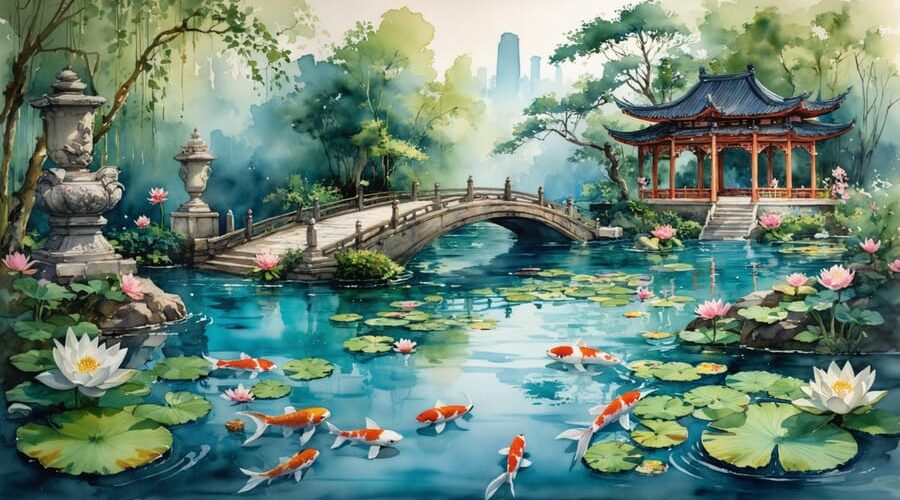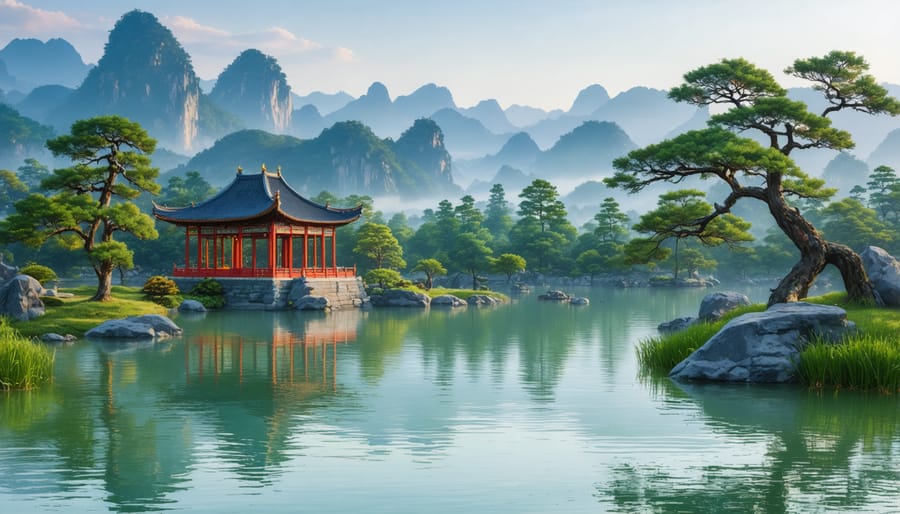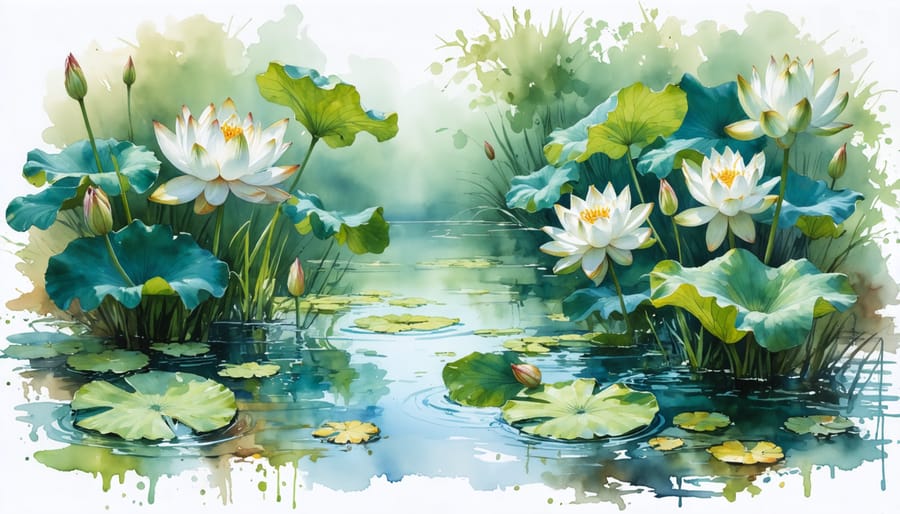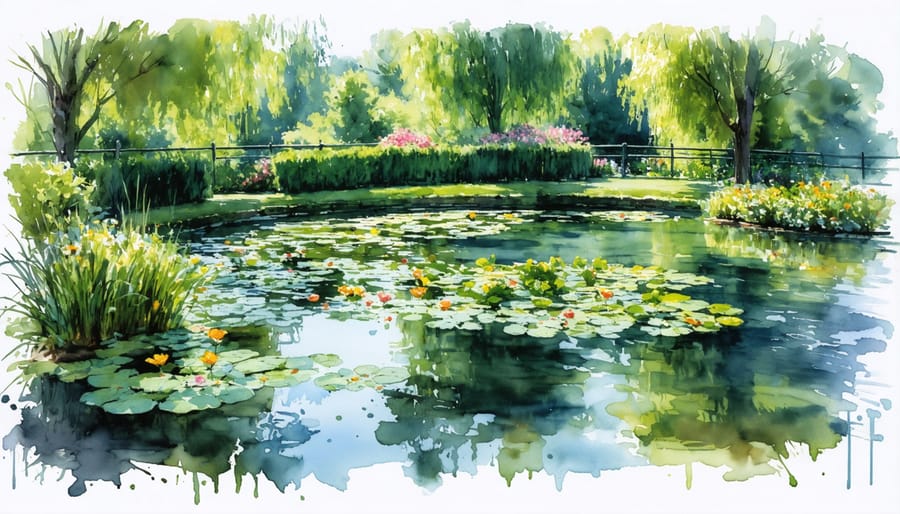
How Water Gardens Shaped the Evolution of Watercolor Art
Watercolor painting’s rich history flows like the very element it harnesses, beginning in ancient cave paintings and evolving alongside water gardens through time. From the delicate papyrus paintings of ancient Egypt to the sophisticated techniques of Chinese landscape artists during the Tang Dynasty, this versatile medium has captured humanity’s imagination for millennia. The Renaissance brought watercolor into European prominence, with artists like Albrecht Dürer elevating it from a mere sketching tool to a respected artistic medium. By the 18th century, British artists had revolutionized watercolor techniques, creating luminous landscapes that celebrated the natural world’s beauty and fluidity. This journey through time reveals not just an artistic evolution, but a deeply human connection to water itself – from the pools that inspired ancient painters to the modern works that continue to reflect our fascination with water’s transformative properties. Today’s watercolor artists inherit this legacy, combining traditional techniques with contemporary innovations to create works that bridge centuries of artistic expression.
Early Origins: Gardens as the First Canvas
Chinese Garden Influence
Chinese scholars of the Tang and Song dynasties developed a distinctive approach to watercolor painting that focused heavily on garden scenes. These scholar-artists would spend countless hours in their private gardens, carefully observing the interplay of light, water, and natural elements before translating their observations onto silk or paper using water-based pigments.
Unlike Western approaches, Chinese garden paintings emphasized the spiritual and philosophical aspects of nature. Artists used diluted inks and subtle color washes to capture the essence of their garden sanctuaries, often incorporating elements like pavilions, bridges, and carefully arranged rocks. The technique of “breaking the ink” (po mo), where varying concentrations of water created subtle gradations, became particularly important in depicting the misty atmosphere of garden ponds and streams.
These paintings weren’t merely decorative – they served as visual poetry, expressing the artist’s deep connection to nature and their understanding of traditional Chinese gardening principles. The influence of these techniques can still be seen in modern watercolor approaches, particularly in the way artists handle transparency and create atmospheric effects in landscape painting.

Japanese Water Garden Art
The artistry of Japanese watercolor painting flourished alongside Japanese garden traditions, creating a unique fusion of nature and artistic expression. During the Edo period (1603-1867), artists developed distinctive techniques to capture the ethereal beauty of water gardens, using delicate brushstrokes and translucent layers to portray rippling water, moss-covered stones, and floating lotus blossoms.
Japanese watercolorists pioneered the use of negative space, allowing the white paper to represent water’s surface while using subtle washes to suggest depth and movement. This minimalist approach, known as “sumi-e,” emphasized the importance of careful observation and spiritual connection with nature. Artists would spend hours studying garden ponds, perfecting their ability to capture fleeting reflections and the interplay of light on water.
The influence of these techniques spread beyond Japan’s borders, inspiring Western artists to embrace more fluid and contemplative approaches to watercolor painting. Today, these traditional methods continue to influence both garden design and artistic representation, reminding us of the deep connection between water gardens and creative expression.
The Renaissance: Water Gardens Meet Western Art
Botanical Illustration Revolution
The 18th and 19th centuries witnessed a remarkable fusion of art and science through botanical illustration, with water gardens playing a pivotal role in this evolution. As explorers discovered new plant species worldwide, the need for accurate botanical documentation grew, and watercolor emerged as the perfect medium for capturing the delicate details of aquatic and garden plants.
Water gardens, with their diverse collection of flora, became living laboratories for artists and botanists alike. The translucent quality of watercolor proved ideal for depicting the subtle variations in leaf structures, flower petals, and the way light played on water-dwelling plants. Artists would spend hours by garden ponds, perfecting techniques to capture the transparency of lotus petals and the intricate patterns of water lily leaves.
The popularity of water gardens among European nobility created increased demand for botanical watercolors, leading to significant technical innovations. Artists developed new methods for layering pigments to achieve greater depth and detail, while the need to accurately represent wet surfaces led to experimental techniques in water control and paint application.
This period also saw the emergence of specialized botanical watercolor papers and brushes, designed specifically for capturing the unique textures and forms found in water gardens. The techniques developed during this era continue to influence modern botanical illustration and have established watercolor as the premier medium for plant documentation.

Villa Garden Documentation
During the Renaissance and Baroque periods, watercolor painting became an essential tool for documenting and designing elaborate villa gardens. Artists and landscape architects used this medium to capture the intricate details of water features, fountains, and botanical elements that characterized these grand spaces. The portability and quick-drying nature of watercolors made them ideal for outdoor sketching, allowing artists to record garden layouts and seasonal changes with remarkable accuracy.
Notable garden designers like André Le Nôtre relied heavily on watercolor sketches to visualize and present their ambitious designs to wealthy patrons. These paintings served both as preliminary design proposals and as historical records, providing modern historians with valuable insights into the evolution of garden aesthetics. The transparency of watercolors proved particularly effective in depicting the play of light on water surfaces and capturing the subtle color variations in foliage.
The practice of garden documentation through watercolors flourished particularly in England during the 18th and 19th centuries. Artists would travel from estate to estate, creating detailed watercolor portraits of carefully planned landscapes and water features. These paintings not only preserved the appearance of historic gardens but also influenced future garden designs, as they were often collected and studied by landscape architects and garden enthusiasts.
The tradition continues today, with many contemporary artists using watercolors to document and design modern water gardens, combining historical techniques with current landscape architecture practices.
Modern Masters and Water Garden Inspiration
Monet’s Water Garden Legacy
Claude Monet’s water garden in Giverny revolutionized not just watercolor painting, but the entire art world’s perspective on capturing the interplay of light and water. His famous lily pond, which he cultivated for over 20 years, became the ultimate outdoor studio where he meticulously studied how sunlight danced on water surfaces throughout different times of day.
Monet’s watercolor techniques, developed while painting his garden, introduced new approaches to capturing reflections and transparency. He pioneered the use of loose, rapid brushstrokes to suggest rippling water and floating vegetation, often working wet-on-wet to achieve subtle color transitions. His method of layering transparent washes helped create the illusion of depth in water, while his careful observation of color variations in reflection became a cornerstone of modern watercolor practice.
The artist’s obsession with his water garden led to innovative color combinations that seemed radical at the time. He would often use unexpected purples and oranges to capture the way light filtered through lily pads, inspiring future generations of watercolorists to experiment with bold color choices. His technique of leaving white paper showing through to suggest sparkles on water remains a fundamental watercolor skill taught today.
Monet’s water garden studies fundamentally changed how artists approach painting water features, establishing techniques that continue to influence contemporary watercolor artists working with natural water scenes.

Contemporary Water Garden Artists
Today’s watercolor artists continue to find endless inspiration in water gardens as living art, creating stunning works that blend traditional techniques with contemporary perspectives. Artists like Paul Jackson and Lian Quan Zhen have revolutionized the way we see water reflections and aquatic plants in watercolor painting, bringing fresh energy to this time-honored medium.
Carol Carter, known for her vibrant blues and striking water compositions, captures the dynamic interplay between light and water in her paintings of water lilies and koi ponds. Her work demonstrates how modern artists can transform traditional water garden subjects into bold, contemporary statements.
Australian artist John Lovett draws inspiration from both natural waterways and designed water gardens, creating atmospheric pieces that celebrate the peaceful quality of water features. His loose, flowing style perfectly embodies the fluid nature of his subjects.
The rise of urban sketching has also influenced how artists approach water gardens, with many creating quick, spontaneous studies that capture the immediate essence of these spaces. This movement has encouraged a more accessible approach to watercolor painting, inspiring both professional artists and hobbyists to document their local water gardens through art.
These contemporary artists prove that the connection between watercolor painting and water gardens remains as relevant today as it was centuries ago, continuing to evolve while honoring this enduring artistic tradition.
Painting Techniques Inspired by Water Gardens
Water gardens have long served as a wellspring of inspiration for watercolor artists, offering unique techniques that mirror the natural flow and interaction of water in garden settings. The rippling reflections of lily ponds, the gentle cascade of fountains, and the interplay of light on water surfaces have influenced how artists approach their craft.
One of the most distinctive techniques inspired by water gardens is the wet-on-wet method, where artists apply paint to already dampened paper. This approach mimics the way water naturally spreads and blends in garden pools, creating soft, organic edges and ethereal color transitions. Artists often use this technique to capture the dreamy quality of morning mist rising from a pond or the subtle color variations in water lily petals.
The glazing technique, another water garden-inspired approach, involves laying transparent layers of color atop one another once each layer has dried. This method perfectly captures the depth and complexity of water, much like the way sunlight penetrates different layers of a pond, revealing various colors and shadows beneath the surface.
Spattering and salt techniques emerged from observing water droplets on leaves and the crystalline formations around garden pools. Artists achieve these effects by flicking paint from a brush or sprinkling salt on wet paint, creating texture that resembles dew drops or mineral deposits often seen around water features.
The practice of negative painting, where artists work around shapes rather than filling them in, draws from the way light plays on water garden elements. This technique is particularly effective for depicting the spaces between water lily pads or the shadows cast by overhanging foliage on water surfaces.
Many artists also employ color lifting techniques, using a damp brush or tissue to remove paint and create highlights, similar to how sunlight creates bright spots on rippling water. This method proves especially useful when painting the reflective qualities of water or capturing the luminous quality of aquatic flowers.
The lasting influence of watercolor painting on our appreciation of water gardens cannot be overstated. Just as artists throughout history captured the ethereal beauty of water features in their paintings, modern garden enthusiasts continue to draw inspiration from these timeless works. The delicate interplay of light and water that fascinated painters centuries ago still captivates us today, influencing how we design and enjoy our outdoor spaces.
These artistic interpretations have shaped our understanding of water’s aesthetic potential, encouraging us to view our gardens not just as functional spaces, but as living works of art. The techniques developed by watercolor masters to capture reflections, ripples, and the interplay of sunlight on water surfaces have become fundamental principles in modern water garden design.
Today, when you create your own water garden, you’re participating in a rich tradition that spans centuries of artistic appreciation. Whether you’re installing a small pond or designing an elaborate water feature, you’re following in the footsteps of countless artists and gardeners who understood water’s unique ability to transform spaces.
The legacy of watercolor painting continues to inspire garden designers and homeowners alike, reminding us that our outdoor spaces can be both naturally beautiful and artistically significant. This connection between art history and modern garden design demonstrates how cultural appreciation for water’s beauty has remained constant through the ages.
